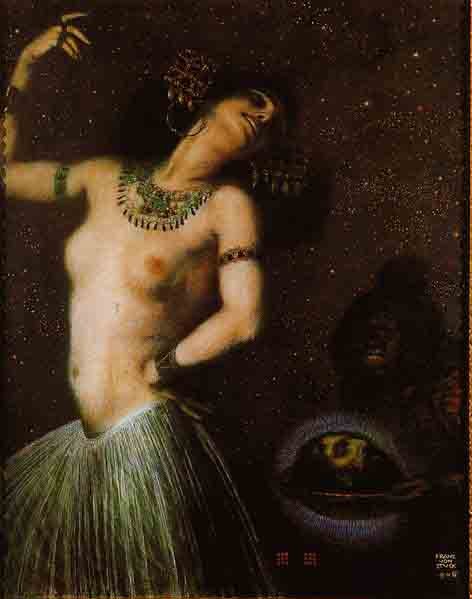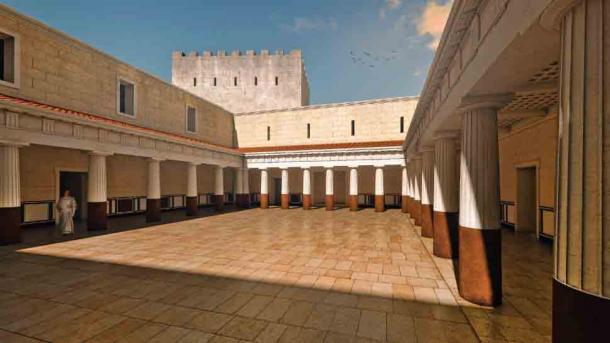A courtyard uncovered among the ancient ruins at Machaerus, a fortified hilltop palace in Jordan, may have profound historical significance. According to one prominent academic, this courtyard is where John the Baptist was condemned to death by the Roman-appointed ruler of Galilee and Peraea (the east bank of the Jordan River), Herod Antipas.
This is the assertion of Gyozo Voros, an archaeologist from the Hungarian Academy of Sciences and the director of an ongoing large-scale excavation project at Machaerus. Voros revealed his provocative conclusions in the recently released book Holy Land Archaeology on Either Side: Archaeological Essays in Honour of Eugenia Alliata .
Salome, Herod Antipas, and the Death of John the Baptist
Taking his lead from a story from the Gospel of Mark in the Bible, Voros now believes this courtyard is the actual spot where Herod Antipas was asked by Salome, his future stepdaughter, to bring her the head of John the Baptist (which he ultimately did, and on a platter no less).
Salome (the daughter of Herodias, Antipas’s fiancé) supposedly performed an intoxicating dance routine in a courtyard at Machaerus, in front of Herod Antipas as he sat on his throne. The dance was intended to be a birthday gift, and it apparently made quite an impression. Totally (and inappropriately) entranced, Antipas promised he would fulfill her fondest desire, as a reward for her loving devotion to her king.
After consulting with her mother, who was apparently not bothered by her future husband’s infatuation with her young daughter, Salome told Antipas to sever John the Baptist’s head and bring it to her as an offering. At that time John the Baptist was a religious figure of some significance, and his opposition to the union of Antipas and Herodias (both were previously divorced) infuriated the future first lady of Galilee and Peraea.
While Antipas was allegedly shocked by the request, he ultimately acquiesced. He ordered John the Baptist’s arrest and subsequent beheading, and that was how the venerated religious prophet who foretold the birth of Jesus lost his life. Or so it is written.

In the New Testament, Salome is claimed to have demanded the head of John the Baptist at the birthday celebrations of her stepfather Herod Antipas. ( Public domain )
In Search of the Throne of Herod Antipas
Perhaps this story was true, and was not just a tawdry tall tale designed to make a reviled former Roman leader look like a moral degenerate. But that alone doesn’t mean the courtyard found at Machaerus was the true location of Salome’s dance floor. More evidence would be needed to draw that conclusion—evidence that Gyozo Voros is convinced he has found.
The Biblical story that describes the death of John the Baptist does not mention Machaerus specifically as the site from which Herod Antipas ruled his small kingdom. But Machaerus was identified by the ancient first century writer and scholar Flavius Josephus as the location of Herod Antipas’s palace, and archaeologists and historians have found no reason to contest that assertion.
The courtyard Voros has tabbed as the likely site of Salome’s famous dance and infamous request was originally discovered in 1980. But it wasn’t identified as a historically significant location until recently, when Voros announced his conclusion that a semicircular-shaped niche located adjacent to the courtyard was once the site of Antipas’s throne. Since Salome performed her dance in front of that throne, if Voros is right it would mean this courtyard had to be the place where she was standing when she asked Antipas to order the arrest and brutal execution of John the Baptist.

Reconstruction of the dance floor where Salome is said to have demanded the head of John the Baptist from her stepfather. (Győző Vörös)
It’s All a Matter of Faith. Or Archaeology and History?
For Voros’s theory to be believed, the story of Salome and John the Baptist in the New Testament must be accepted as gospel, both figuratively and literally. It should be noted however that Flavius Josephus, whose claim that Herod Antipas ruled his assigned territory from Machaerus has been universally assumed to be true, gave an alternative explanation for John the Baptist’s death. He wrote that Antipas felt threatened by John’s rising popularity with his Jewish subjects, who acknowledged John as a true prophet and an important religious leader. Antipas’s insecurity is what led to the arrest and murder of John the Baptist, Flavius Josephus asserts, and he makes no mention of beheading as the prescribed method of execution.
Some scholars are willing to grant the possibility that the Biblical explanation for John’s death may be accurate. But they remain skeptical of Voros’s theory regardless. For example, Jodi Magness, a professor of religious studies at the University of North Carolina, notes that the structure found at Machaerus seems small compared to the structure that once supported the throne of Antipas’s father, the original King Herod . Magness told Live Science that the semicircular niche discovered at Machaerus more closely resembles a pair of structures found at one of King Herod ’s palaces, which precisely no one believes are the remains of ancient thrones.
Another mild but respectful skeptic is Eric Meyers, a retired professor of Jewish Studies from Duke University. He credits Voros with making a strong case for his hypothesis, before stating that it remains to be seen whether “a perfect match between literary and archaeological sources that places the execution of John the Baptist is that very spot” can ever be established.
Politely, Meyers is pointing out the impossibility of ever conclusively proving that John the Baptist was killed for the reasons given in the Bible, or that the events portrayed in the Gospel of Mark pertaining to John’s execution happened at all. While the faithful who accept the Bible as definitive history may have no problem supporting Voros’s theory, most serious academic researchers demand a more persuasive foundation of proof.
As a rule, they base their final conclusions on the existence of sound physical evidence (in the case of archaeologists) or textual confirmation from multiple contemporary sources (in the case of historians). In this instance, it seems unlikely that such indisputable evidence will ever be discovered.
Top image: Archaeologists believe that this niche represents the remains of the throne of Herod Antipas. Now Gyozo Voros has concluded this is the exact location where Salome demanded the head of John the Baptist. Source: Győző Vörös
By Nathan Falde
Related posts:
Views: 0
 RSS Feed
RSS Feed















 January 6th, 2021
January 6th, 2021  Awake Goy
Awake Goy  Posted in
Posted in  Tags:
Tags: 
















